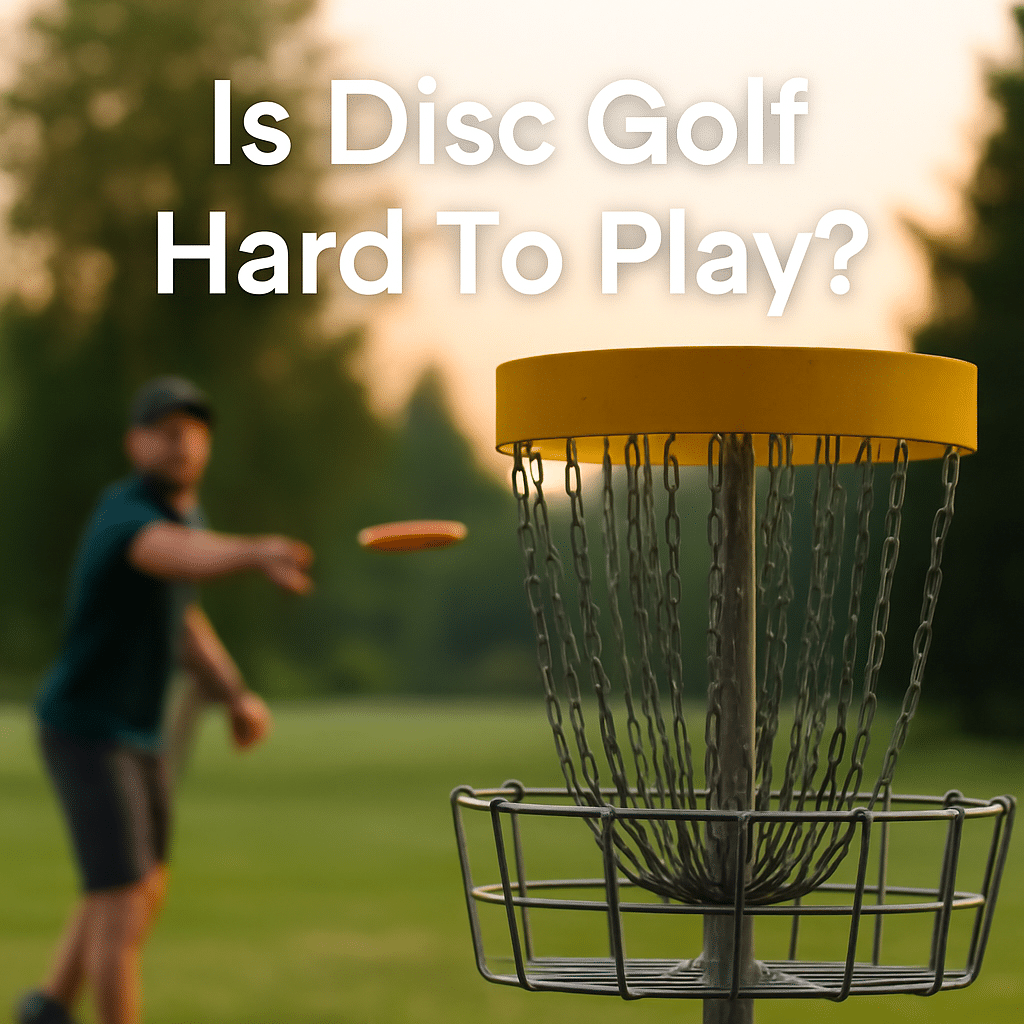
Disc golf looks simple: throw a disc toward a basket and keep score like golf. But if you’re new, it can feel tricky. In my experience, the game is only “hard” when we jump in without the right discs, basic form, or a plan for practice. The good news—anyone can improve quickly with a few smart choices.
So…Is Disc Golf Hard?
Short answer: it can be at first. Long answer: it gets easier fast when you build good habits. Most players struggle early with consistency, distance, and putting. With the right discs and some focused practice, you’ll see progress in weeks—not years.
Why Disc Golf Feels Hard at First
- Accuracy under pressure: Hitting a line through trees takes reps.
- Limited throws: Every throw counts, so early mistakes feel costly.
- Uneven terrain: Hills, wind, and footing change your throw.
- Obstacles: Trees, rough, and out-of-bounds force smart decisions.
- Focus: Small lapses—talking, rushing, scrolling—lead to misses.
How to Make Disc Golf Easier (Fast)
1) Start with Beginner-Friendly Plastic
Choose slower, understable molds in lighter weights. They’re easier to control and help you learn clean form. A budget-friendly way to start is a disc golf starter set, which includes a putter, midrange, and driver chosen for new players.
If you want an even simpler setup, try a two-disc kit with a putter and easy driver like this Divergent 2-Disc Beginner Set. It keeps cost down and shortens the learning curve.
2) Learn One Clean Throw First
You don’t need every shot on day one. Dial in a smooth backhand with a neutral midrange or fairway. Focus on a flat release, chest-high reach back, and a balanced follow-through. Once that’s consistent, add hyzers, anhyzers, and forehand.
3) Technique Over Power
Power comes from clean mechanics, not muscling the disc. Shorten your run-up, keep your head calm, and feel the disc rip from a loose grip—not a tight squeeze. As your form cleans up, distance shows up.
4) Pick Lines You Can Hit
Map the fairway from tee to landing zone like chess. If a straight gap at 220 ft is your shot, play it—even if a hero line could go farther. Scoring well is about placement, not max distance.
5) Build a Simple Putting Routine
Putting turns “hard” into “manageable.” Practice 10–15 minutes, 4–5 days a week. A target makes practice easy at home; explore our practice baskets to build confidence from 15–25 feet.
6) Use the Right Fairway Driver
Newer arms often benefit from an understable fairway that flips up and glides. One I like for developing players is the Innova Sidewinder (Star). It’s workable for hyzer-flips, gentle turnovers, and learning angle control.
7) Create a 30-Minute Practice Plan
- 5 minutes: standstill midrange throws (form focus).
- 10 minutes: fairway shots at one target (same disc, same line).
- 10 minutes: putts from 15–25 ft (routine + pace).
- 5 minutes: approach touch (forehand or backhand) inside 150 ft.
Track makes/misses. Small, repeatable sessions beat occasional marathons.
8) Play with Better Players
Ask local cardmates about disc choices and lines. Most disc golfers are happy to help. You’ll pick up course management quicker than you think.
9) Set Realistic Goals
Examples: “No double-bogeys for nine holes,” or “Make 7/10 putts from 20 ft.” Clear, simple targets build momentum and keep rounds fun.
10) Keep It Affordable and Enjoyable
You don’t need a huge bag. A putter, a midrange, and a fairway driver can shoot great scores. If you’re curious about what drivers make sense early on, here’s a helpful read: Best Disc Golf Drivers for Beginners. Start small, upgrade as your form improves.
Recommended Beginner Builds
Budget-Friendly (2 Discs)
- Putter for putting + approaches
- Understable fairway driver for controlled distance
- Optional: Add the 2-Disc Starter Set if you want an easy, low-cost bundle.
Balanced Starter Set (3 Discs)
- Putter (circle putts + short approaches)
- Neutral/understable midrange (straight practice)
- Understable fairway driver (hyzer-flip distance)
- See current options in our Starter Sets.
Single Disc to Learn Angle Control
- Innova Sidewinder (Star) — great for learning flat, hyzer-flip, and soft turnover lines.
The Bottom Line
Disc golf can feel hard at the start, but it becomes a lot easier with the right discs, simple practice, and smart course choices. Keep the bag small, work on clean form, and build a putting habit. If you do that, scores drop fast—and you’ll have more fun each round.
Want help choosing discs? I’m happy to recommend a simple setup based on your skill level and typical course. Tell me what you’re throwing now, and I’ll suggest an affordable upgrade path.
